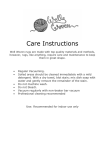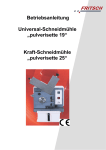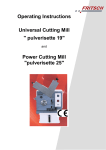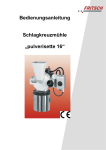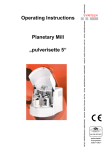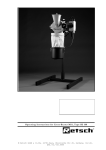Download Operating Instructions Cross Beater Mill “pulverisette 16”
Transcript
Operating Instructions Cross Beater Mill “pulverisette 16” Fritsch GmbH Laborgerätebau Industriestrasse 8 D - 55743 Idar-Oberstein Phone: Fax Email: Internet: +49 (0)6784/ 70-0 +49 (0)6784/ 70-11 [email protected] http://www.fritsch.de Fritsch GmbH, Laborgerätebau was certified by TÜVZertifizierungsgemeinschaft e.V. on November 21, 2003. It was verified through an audit that Fritsch GmbH satisfies the requirements of DIN EN ISO 9001:2000. The enclosed conformity declaration specifies the directives satisfied by the Cross Beater Mill “pulverisette 16” in order to qualify for the CE mark. Device number 16.300x.00 Applies as of serial number 101 Version 12/2000 Index 002 Inspected and Approved Table of contents Page 1 General/Introduction................................................................1 1.1 1.2 1.3 Notes about the operating instructions................................................. 1 Explanation of the symbols used on the device and in the operating instructions ............................................................................................ 2 Brief description of the device .............................................................. 3 1.3.1 1.3.2 Fields of application ......................................................................................... 3 Method of operation ......................................................................................... 3 1.4 1.5 Technical data ...................................................................................... 4 Materials and composition.................................................................... 5 2 Operating safety.......................................................................6 2.1 2.2 2.3 2.4 General safety instructions................................................................... 6 Operators.............................................................................................. 6 Protective devices ................................................................................ 7 Danger points ....................................................................................... 7 3 Installation ................................................................................8 3.1 3.2 3.3 3.4 3.5 3.6 Unpacking............................................................................................. 8 Transport .............................................................................................. 8 Setup .................................................................................................... 8 Setup on a laboratory table .................................................................. 8 Fastening of the “pulverisette 16” to the universal support .................. 9 Electrical connection........................................................................... 10 4 Working with the “pulverisette 16” ......................................11 4.1 4.2 4.3 4.4 4.5 4.6 4.7 Operating elements and operation ..................................................... 11 Operating elements and their function ............................................... 12 Opening and closing the mill housing ................................................ 13 Inserting the bottom sieve .................................................................. 14 Filter hose and collecting vessel ........................................................ 14 Adding material for grinding ............................................................... 14 Readjusting the impact gap................................................................ 15 5 6 7 8 Cleaning ..................................................................................16 Maintenance ...........................................................................17 Required inspections.............................................................17 Warranty..................................................................................18 pulverisette 16 1 General/Introduction 1.1 Notes about the operating instructions • Study the operating instructions carefully. • The cross beater mill “pulverisette 16” is referred to below as the cross beater mill. • All operators must be familiar with the contents of the operating instructions. • Please follow the notes for your safety. • The cross beater mill was designed from a perspective of user safety; however, some residual dangers could not be eliminated. Follow the advice in these instructions to avoid risks to users. • The symbols in the right hand margin highlight the risks described in the text. • Symbols on the device warn about possible dangers or refer to these operating instructions. The symbol in the right page margin (triangle with an exclamation point) indicates general dangers and refers to the operating instructions. • These operating instructions do not constitute a complete technical description. They describe only the details required for safe operation and maintenance for usage under normal conditions. • The copyright to these technical documents is the property of Fritsch GmbH, Laborgerätebau. • These operating instructions are not to be reprinted or copied without the express approval of Fritsch GmbH, Laborgerätebau. pulverisette 16 Page 1 1.2 Explanation of the symbols used on the device and in the operating instructions Attention! Warning against danger spot Observe operating instructions Attention! Mains voltage Attention! Hazard of explosion Wear ear protection! Wear protective gloves! Spraying with water forbidden! Do not step below lifted load! pulverisette 16 Page 2 1.3 Brief description of the device 1.3.1 Fields of application The cross beater mill serves primarily for preliminary and fine comminution of medium-hard, brittle materials up to Mohs hardness of 6. Thanks to a large selection of accessories, the cross beater mill is a device with wide-ranging fields of application primarily in the areas of chemicals and ceramics, in mining and metallurgy as well as in the preparation of soil samples, etc. in the laboratory and in industry. The achievable final fineness depends on the hole width of the bottom sieve and the grinding properties of the material to be ground. Under good conditions, fineness levels < 100 µm can be achieved. Typical applications for soft materials: Needles, leaves, grain, resins, cellulose, chemicals, dried fruits, peat, seeds, dried plants Typical applications for medium-hard materials: Animal feed, salts, pellets, coal, porcelain clay, spices, gypsum, drugs, potash, tablets, slag, minerals, ash, stone and earth (bauxite, limestone, dried clay, etc.), synthetic resins, pyrite, cement clinker, coke, ores, refractory materials. 1.3.2 Method of operation The comminution in the cross beater mill takes place through impacting, colliding and shearing effects. After introduction into the filling funnel, the material enters the grinding chamber, where the comminution process occurs between the cross beater, grinding insert and bottom sieve. As soon as the material has reached the corresponding final fineness, it passes through the bottom sieve into the collecting vessel. A back draft of the air flow generated by the rotating cross beater is prevented and an acceleration of the material throughput is partially achieved with the use of a textile filter hose between the cross beater mill and the collecting vessel. This ensures a gentle grinding process. pulverisette 16 Page 3 1.4 Technical data Dimensions: “pulverisette 16” approx. 560x420x445mm (height x width x depth) “pulverisette 16” with base frame approx. 1183x560x700mm (height x width x depth) Weight: “pulverisette 16” net approx. 36 kg with base frame net approx. 58 kg Operating noise Noise measurement according to DIN 45635-31-01-KL3 The noise values are also influenced by the properties of the material being ground. Example: Noise level LWA = 95dB(A) Workplace emissions value LpAeq = 86dB(A) Input material: Quartz pebbles, grain size < 3 mm Filling level of the grinding chamber: Input quantity until rated motor power was reached Drive: 1 and 3 phase alternating current motor with brake Rotation speed: 2850 rpm Rated power: 1100 watts Input grain size: Max. 20 mm Collecting vessel volume: 5,000 ml or 30,000 ml Protection class: IP 54 pulverisette 16 Page 4 1.5 Materials and composition Collecting vessel 5l and bottom sieves of stainless steel Material no. Short name 1.4301 X 5 CrNi 18 9 Composition Fe Cr Ni Mn Si C P S 77.325 18.000 02.500 02.000 01.000 00.070 00.045 00.030 % % % % % % % % Al Si Fe Mg Mn Ti Zn Cu 87.300 11.000 00.500 00.500 00.400 00.150 00.100 00.050 % % % % % % % % Fe C Si Mn P S 93.600 03.650 01.800 00.550 00.300 00.100 % % % % % % Fe C Si Mn P S 95.465 03.250 00.650 00.400 00.055 00.180 % % % % % % Fe Cr C Mn Si P S 84.890 12.000 02.200 00.450 00.400 00.030 00.030 % % % % % % % Filling funnel and housing of aluminium Material no. Short name 239 G-Al Si 10 Mg Composition Grinding insert of cast iron Short name GG-20 Composition Cross beater of tempered cast iron Material no. Short name 0.8083 GTW-38 Composition Impact plates of special steel Material no. Short name 1.2080 X 210 Cr 12 Composition The composition percentages listed above represent average values. pulverisette 16 Page 5 2 Operating safety 2.1 General safety instructions • Study the operating instructions carefully. • All operators must be familiar with the contents of the operating instructions. For this purpose, always keep the operating instructions within easy reach. • Do not remove the instruction labels. • Do not disable safety devices. • Independent conversions of the device negate the conformity with European directives declared by Fritsch and void the warranty. • The cross beater mill is intended exclusively for use as specified in the section 1.3.1 . Any other use is considered improper; the manufacturer accepts no liability for damages resulting from improper use. • In addition to the operating instructions, observe and instruct adherence to all generally applicable statutory and otherwise binding regulations on accident prevention and environmental protection. • If a noise level of 85 dB(A) is reached or exceeded, hearing protection should also be worn to prevent hearing damage. • Use original accessories and spare parts only. Failure to adhere to this may jeopardize the protection of the machine. • Do not continue using damaged accessories. • The occupational exposure limits of the valid safety instructions must be observed and if necessary, ventilation should be provided or the machine should be operated under a hood. • During comminution of oxidisable substances (e.g. metals or coal), there exists a danger of self-ignition (dust explosion) if the portion of fine material exceeds a specific percentage. • The cross beater mill is not designed with explosion protection and is not suitable for grinding of explosive materials. • These operating instructions do not contain any repair instructions. Repairs may only be performed by Fritsch GmbH or authorised service technicians. 2.2 Operators • • pulverisette 16 The cross beater mill may only be operated by authorised persons and maintained and repaired by trained experts. People who are under the influence of health impairments, medications, drugs, alcohol or excess fatigue may not operate the cross beater mill. Page 6 2.3 Protective devices • Protective devices should be used for the intended purpose and must not be made unserviceable or removed. • All protective devices must be regularly inspected for completeness and proper function. See sections 6 Maintenance and 7 Required inspections. 2.4 Danger points Process Safety Packaging Transport Temperature fluctuations Action Damages and injuries resulting from failure to follow the safety instructions Please keep the packaging for the duration of the warranty period Do not jolt, shake or throw the “pulverisette 16” during transport In event of temperature fluctuations, protect the “pulverisette 16” from condensation In event of incomplete delivery and/or transport damages, you must immediately notify the shipper and Fritsch GmbH (within 24h). Falling below 5 °C Exceeding 40 °C Dangers All forms of claims for damages are excluded A complaint and return in insufficient packaging can put your warranty claims at risk Electronic and mechanical components can be damaged Electronic components can be damaged Complaints registered later than this can no longer be accepted under some circumstances. Electronic and mechanical components can Ambient temperature be damaged Performance data changes to an unknown extent. Exceeding of 80 % at Electronic and mechanical components can Humidity temperatures up to 31 °C be damaged Performance data changes to an unknown extent. Power network does not match the values on Electronic components can be damaged Electrical connection the type plate Before starting up the device for the first time, With an incorrect rotation direction, the grindthe rotation direction must be checked; see the ing performance is insufficient and mechanical components may be damaged. directional arrow on the motor. Opening and closing of the mill Only close the door when the contact surfaces Mechanical components and the seal can be damaged. are absolutely free of grinding material and housing other contaminants. Do not open “pulverisette 16” while the motor In the grinding of toxic or otherwise harmful is running. substances, there is a risk of inhalation of dusts that are harmful to health. Do not open the “pulverisette 16” and release Risk of injury from the unbraked cross the motor brake at the same time. beater. Add material for grinding slowly and continu- Adding too large an amount can bring the Adding material for grinding ously into the filling funnel. “pulverisette 16” to a stop and could damage mechanical components. During grinding, dust-sized grinding material Danger of inhalation of harmful dusts. can escape from the filling funnel. Use a vacuum hood when working with toxic or otherwise harmful materials. Some grinding materials form explosive mix- Risk of explosion. tures in air. Check the material properties of your grinding material. Pull the power plug before every cleaning. Cleaning Life-threatening risk of electric shock Do not clean with flowing water Life-threatening risk of electric shock Scope of delivery pulverisette 16 Page 7 3 Installation 3.1 Unpacking • Pull out the nails with which the shell is fastened to the transport pallet. The shell is the wooden box that is situated over the transport pallet. • Lift the shell off the transport pallet. • Compare the contents of the delivery with your order. 3.2 Transport • Transport with a forklift or elevating truck while on the transport pallet. • Use the ring bolt H for transport of the cross beater mill. Do not stand under the transport pallet! 3.3 Setup • Lift the cross beater mill off the transport pallet. Observe the accident prevention guidelines VBG 8, VBG 9a and VBG 9! • Set up the cross beater mill horizontally on a level and stable indoor surface. It is not necessary to fasten the device in place. Operation of the cross beater mill while it is on the transport pallet is not permitted! • Ensure easy access to the cross beater mill. • The ambient temperature must range from 5–40 °C. • The max. humidity up to 31 °C is 80 % and declines linearly to 50 % at 40 °C. • The minimum elevation for setup and use of the device is 200 m below sea level. 3.4 Setup on a laboratory table You can also mount the cross beater mill onto your laboratory table. - Measure the laboratory table thickness. - Use screws with a max. diameter of 8 mm and a length of the laboratory table thickness plus 25 mm. - Place the cross beater mill including collecting vessel on the table. - Mark the hole locations onto the table using the existing holes on the motor of the cross beater mill. The spacing from the holes to the front edge of the table must allow sufficient space for installation and removal of the collecting vessel and the filter hose. pulverisette 16 Page 8 3.5 Fastening of the “pulverisette 16” to the universal support Lift the mill onto the support with 2 people. Important!!! Secure the device against tipping until it is completely screwed in place, since the mill’s centre of gravity allows it to tip forward. Attention! Warning against danger spot Then fasten the mill to the installation plate with the supplied fastening materials. Warning against hand injury Mounting holes “pulverisette 16” pulverisette 16 Page 9 3.6 Electrical connection The electrical connection may only be created by a qualified electrician. The voltage and frequency of the cross beater mill can be found on the type plate. Make certain that the values match the existing power network. Connect the cross beater mill to the power network using the supplied connector cable. The supplied power cable does not have a plug, since the type of plug depends on the setup location and the respective national regulations. External fuse protection must be provided during connection of the power cable to the mains in accordance with the regulations of the setup location. Direction of rotation of the drive motor Viewed from the drive side, the 3-phase AC motor should rotate anticlockwise. (Viewed from the front, looking at the cross beater mill, anticlockwise; viewed from the rear, clockwise.) The single-phase AC motor is factory-set to rotate anticlockwise. See: • DIN VDE 0530 part 8 “Terminal marking and direction of rotation” • DIN VDE 0530 Teil 7 / EN 60 934-7 “Type codes”. The direction of rotation of the 3-phase motor can be changes by swaping two of the leads, L1, L2 and L3 (either at the motor terminals or in the plug). The direction of rotation may only be changed by a trained electrician. pulverisette 16 Page 10 4 Working with the “pulverisette 16” 4.1 Operating elements and operation Graphical view of the operating elements: pulverisette 16 Page 11 4.2 Operating elements and their function Item Element A Main switch with ON/OFF button A1 Power switch with knob B1 Door seal hand wheel only with PULVERISETTE 16 comfort Filling funnel at door D Symbol 0 I E Filter hose w/o illustration F Collecting vessel 5l Release level for the motor brake w/o illustration G H pulverisette 16 Transport bolt Function Disconnects and connects the “pulverisette 16” from/to the mains I pressed = “pulverisette 16” is switched on 0 pressed = “pulverisette 16” is switched off Disconnects and connects the “pulverisette 16” from/to the mains ON = “pulverisette 16” is switched on OFF = “pulverisette 16” is switched off Opens and closes the door of the “pulverisette 16” comfort, places tension on the door seal Pressed and rotated right = closes the door Pressed and rotated left = opens the door Receives the grinding material with a maximum grain size of 20 mm; not intended for storage of a grinding material reserve; Reliably prevents backspray of the grinding material. Prevents a back draft from the air pressure generated by the rotating cross beater, thereby accelerating the material throughput. Receives the ground material. Pushing back releases the motor brake, allowing manual turning of the cross beater for cleaning. Prevents damage to mechanical and electrical components during transport. Page 12 4.3 Opening and closing the mill housing Only open the “pulverisette 16” while it is switched off. - Press the button 0 on the power switch A or turn to the OFF setting (see image) - Press the hand wheel B1 and turn to the left - The hand wheel snaps into the final position - Close in reverse order 0 I Important: Only close the door when the contact surfaces are absolutely free of grinding material and other contaminants. Mechanical components and the seal can be damaged. Do not open “pulverisette 16” while the motor is running. In the grinding of toxic or otherwise harmful substances, there is a risk of inhalation of dusts that are harmful to health. Do not open the “pulverisette 16” and release the motor brake at the same time. Risk of injury from the unbraked cross beater. pulverisette 16 Page 13 4.4 Inserting the bottom sieve Bottom sieves BS of stainless steel with Conidur or round perforation are available as accessories. (See image) Conidur 0.12/0.2/0.25/0.5/0.75/1/1.5/2 mm Round hole 3/4/5/6/8/10 mm • • • • • • • Stop the “pulverisette 16” Open the mill housing Insert the bottom sieve BS Set the impact gap between the grinding insert and cross beater to 1mm, with a bottom sieve to cross beater spacing of not < 1 mm. Close mill housing Make certain that a collecting vessel is in place. Start the “pulverisette 16” Important: Never operate the device without a bottom sieve inserted! Risk of injury through possible insertion of fingers from below! 4.5 Filter hose and collecting vessel Through the use of a textile filter hose between the “pulverisette 16” and the collecting vessel, the airflow generated by the rotating cross beater is guided away and a back draft is prevented. In addition, it accelerates the material throughput and ensures a gentle grinding process. * Slide filter hose E over the flange, and at the same time hold the clamping clip at an angle * Clamp on seal E1 * Hang in the collecting vessel F * Clamp on seals F1 If the collecting vessel is installed without filter hose, you can expect dust to escape from the filling funnel D. 4.6 Adding material for grinding The maximum grain size should not exceed 20 mm. * Add grinding material slowly into the filling funnel D (see image) A rebound blocker in the filling funnel prevents the grinding material from being thrown back out. pulverisette 16 Page 14 4.7 Readjusting the impact gap From time to time, the gap between the grinding insert and the impact plates of the cross beater should be inspected. (See image) * * * Pull the power plug Open the mill housing Check the gap between the grinding insert ME and the impact plate PP with a feeler gauge = desired value ~ 1 mm, whereby the gap to the bottom sieve may not be < 1 mm Adjust the gap between the grinding insert and impact plate, if necessary. * Screw the impact plates tight with a hex key M5 pulverisette 16 Page 15 5 Cleaning The cross beater mill can be cleaned while switched off using brushes, small brushes and possibly vacuumed with an industrial vacuum cleaner or blown off with compressed air. Do not allow any liquids to flow into the device. To clean the grinding chamber in the cross beater mill, the motor brake can be released with lever G. The cross beater is easy to turn, making cleaning simpler. The protection class of the cross beater mill is IP54 pulverisette 16 Page 16 6 Maintenance • Before the start of maintenance work, pull the power plug and secure the device against accidental reactivation! • • • Warn about maintenance work with a sign. Only have maintenance work performed by experts. Put safety devices back into operation after maintenance and repair work. The cross beater mill requires almost entirely no maintenance. From time to time, the gap between the grinding insert and the impact plates of the cross beater should be inspected. Procedure: - - 7 Pull the power plug Open the mill housing Check the gap between the grinding insert GI and the impact plate IP with a feeler gauge = desired value 1 mm, whereby the gap to the bottom sieve may not be < 1 mm Adjust the gap between the grinding insert and impact plate, if necessary. Required inspections • • • • Before the start of repair work, pull the power plug and secure the device against accidental reactivation! Warn about repair work with a sign. Put safety devices back into operation after maintenance and repair work. Only have repair work performed by experts. The limit switch and the motor brake should be tested for proper function every six months. - Limit switch on the door hinge on the left o With an opening gap of max. 3 mm, the limit switch must switch off the motor - Limit switch on quick latch on the right o Upon a rotation of the hand wheel of max. 45°, the motor brake must be activated - Motor brake o Start device o Stop device o If the braking time exceeds 0.5 seconds, contact a service technician pulverisette 16 Page 17 8 Warranty The warranty card enclosed with the device upon delivery must be completely filled out and returned to the delivering factory so that the warranty can enter into effect. Online registration is also possible. More information can be found on your warranty card or on our homepage http://www.fritsch.de The company Fritsch GmbH in Idar-Oberstein and its “Technical Application Laboratory” or the corresponding national representatives would be happy to provide you with advice and assistance. Please include the serial number given on the type plate along with any questions. pulverisette 16 Page 18

























